
This blog has moved. Please visit us at www.preparednesspro.com.
Well, at least those of us who are addicted to cheese anyway.
-
Can you name at least 10 different kinds of cheese that you love?
-
Do you believe that cheese should be its own food group?
-
Are you helpless to abide by your diet unless it involves huge amounts of melted cheese?
Then this article is for you!
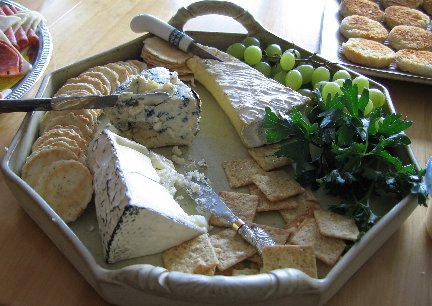 So picture this. It’s a bona fide emergency survival situation. You are holed up on your home and living off of the emergency preparedness supplies you stored. And you’ve got one heck of a hankering for some yummy melted cheese. But you’re just not in the mood for the Velveeta, that nasty powdered stuff, or the “squirt” kind of cheese. You want a good solid bite of a yummy Parmesan, or Swiss, or a sharp cheddar. (I’m making myself drool even as I write this.) But hey, cheese doesn’t store for a very long time, right? Well, in this case, I’m happy to tell you that you’re wrong. And if you’re a true cheese addict, then you’ll be happy to hear that you’re wrong for once, right?
So picture this. It’s a bona fide emergency survival situation. You are holed up on your home and living off of the emergency preparedness supplies you stored. And you’ve got one heck of a hankering for some yummy melted cheese. But you’re just not in the mood for the Velveeta, that nasty powdered stuff, or the “squirt” kind of cheese. You want a good solid bite of a yummy Parmesan, or Swiss, or a sharp cheddar. (I’m making myself drool even as I write this.) But hey, cheese doesn’t store for a very long time, right? Well, in this case, I’m happy to tell you that you’re wrong. And if you’re a true cheese addict, then you’ll be happy to hear that you’re wrong for once, right?
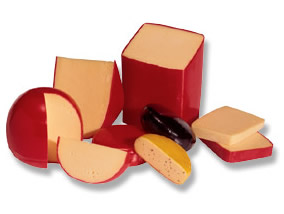 So here’s the good news. You CAN have your favorite cheese on hand, even in an emergency, and even though no stores are open and you have no access to electricity. All you have to do is buy the hard blocks of cheese that you want now in order to have them stored for up to the next 25 years. Cheese wax prevents your cheese from developing mold or bacteria and it keeps the moisture in. Simply use a combination of dipping and brushing with a natural boar’s hair brush to apply the melted cheese wax liberally to your block of cheese, let it harden, and then, VOILA – you’ve got your wish. Cheese treated with cheese wax will store for up to 25 years at a mild to cool temperature. Sure, it will continue to age. But it sure won’t get moldy! (And even if it does in parts, you can simply cut off that part, and re-wax over it.) Be sure that you select block sizes of cheese that you and your family can easily consume within a 3 to 5 day period in order to avoid it going bad once you’ve cut into it.
So here’s the good news. You CAN have your favorite cheese on hand, even in an emergency, and even though no stores are open and you have no access to electricity. All you have to do is buy the hard blocks of cheese that you want now in order to have them stored for up to the next 25 years. Cheese wax prevents your cheese from developing mold or bacteria and it keeps the moisture in. Simply use a combination of dipping and brushing with a natural boar’s hair brush to apply the melted cheese wax liberally to your block of cheese, let it harden, and then, VOILA – you’ve got your wish. Cheese treated with cheese wax will store for up to 25 years at a mild to cool temperature. Sure, it will continue to age. But it sure won’t get moldy! (And even if it does in parts, you can simply cut off that part, and re-wax over it.) Be sure that you select block sizes of cheese that you and your family can easily consume within a 3 to 5 day period in order to avoid it going bad once you’ve cut into it.
A couple of tips you should know though.
 Don’t use paraffin wax. It tends to crack. Cheese wax warms slower and heats to a higher temperature and thus plies better to your cheese shapes and sizes. Cheese wax is also less crumbly and you can use less of it than paraffin. Remember, it’s reusable too!
Don’t use paraffin wax. It tends to crack. Cheese wax warms slower and heats to a higher temperature and thus plies better to your cheese shapes and sizes. Cheese wax is also less crumbly and you can use less of it than paraffin. Remember, it’s reusable too! - I have yet to find a hard cheese that I can’t wax. So long as it’s hard enough to be in a solid block, you can wax it.
- You don’t need cheesecloth, but if you desire to use it prior to your wax layers, it may be helpful getting the wax off. I haven’t had any problems without it though.
- It’s best to melt the cheese wax in a double boiler as opposed to direct heat. Any pan you use to melt your cheesewax in will be your designated cheese wax pan. They are impossible to get clean afterwards. So be forewarned.
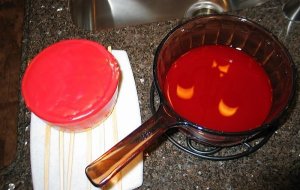 The less you handle the cheese with your hands the better. Use food handling gloves.
The less you handle the cheese with your hands the better. Use food handling gloves. - Dip the cheese in for about 5 seconds, then bring it out and HOLD it there for about 90 seconds. Do 3 layers of dipping and then one layer of brushing. (Using the natural boar’s hair brush) The reason why you want to use this kind of brush specifically is because other brushes will apply the cheese wax too thick, or with crevices, etc. This kind of brush is perfect for cheese waxing.
- You don’t need to use food-grade labels for your cheese, however, it’s smart to use a label on the outside of your cheese just prior to the last wax layer. That way you don’t have to worry about it falling off. Be sure to label not only the kind of cheese it is, but when it was waxed as well.
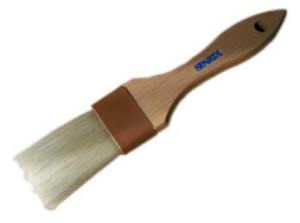 Don’t store your waxed cheese in additional containers. Just stack them on top of like cheeses and let them breathe. I like to hang them from the ceiling in a “fishing net” kind of contraption.
Don’t store your waxed cheese in additional containers. Just stack them on top of like cheeses and let them breathe. I like to hang them from the ceiling in a “fishing net” kind of contraption. - Be sure to check for pockets or crevices that didn’t get sealed. Four total thin layers of wax is a good practice. There’s no need to do more coats than that.
- The cheese surface should be clean and dry prior to waxing.
- If your 2nd and 3rd coats are applied while the prior coat is still just a bit warm you will get a better adhesion.
- Cheese wax can be re-used several times. You can simply wash it in warm water, let it dry and then re-melt it. So when you remove cheese wax from your cheeses, you can simply reheat and reapply the wax. Simply heat the cheese wax to about 200 degrees F. This will also ensure that you’re not transferring any bacteria or unnecessary moisture to your new cheese–even when you’re putting it on your cheese which is cooler.
- You do not need to filter the cheese wax after you melt it. So don’t worry about that step.
- Your first coat will have some unevenness to it. Don’t worry. The 2nd and 3rd coat will even it out just fine.
- Cheese will respond to gravity. So using cheesewax vs. paraffin is important as it’s more pliable. I periodically turn my cheese in view of the gravitational pull.
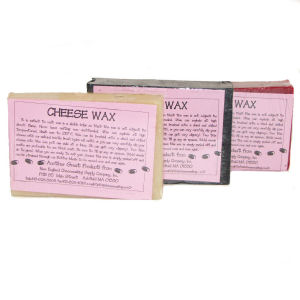 Cheese wax can be found multiple places online or in your local health food stores. I also recommend that you use red or black cheesewax as it will prevent more light from getting int. You should also have no problem finding a boar bristle brush either.
Cheese wax can be found multiple places online or in your local health food stores. I also recommend that you use red or black cheesewax as it will prevent more light from getting int. You should also have no problem finding a boar bristle brush either.
Once you get the hang of this cheese waxing stuff you can progress to making your own cheese from powdered milk in any flavor you decide! Yummy!
Enjoy the recipe below!
Kristen’s Cheesy Roughin’ It Enchiladas
1 can of tomato soup
1 can of cream of chicken soup
1 regular sized can of enchilada sauce
2 cups of canned chicken, drained
About 2 cups of your favorite shredded cheese
 Make your sauce by combining the soups and the enchilada sauce.
Make your sauce by combining the soups and the enchilada sauce.
Use enough flour or corn tortillas to line a large baking dish or Dutch oven with your enchiladas (About 12 to 15 depending on how big you stuff them). Be sure to spray your dish with some cooking spray.
Lightly coat the bottom of your tortilla with the sauce. Then add about 2 tablespoons of chicken, according to your desire. Top the chicken with about 2 tablespoons of cheese. Then roll up your tortilla and place seam side down in the dish. Continue until you’ve filled the dish a single layer deep. Once you’re finished, pour the remaining sauce over the top and top with the remaining cheese. Bake at 350 degrees for about 30 minutes until the cheese is completely melted. You can add chopped black olives, black beans, rice, or even green chilies to this recipe as well.
Preparedness Pro Note: If you would like Kellene Bishop to present an Emergency Preparedness message for your community or church group, please contact us at 801-788-4133. Ms. Bishop is an experienced speaker and demonstrator on Emergency Preparedness topics and also has created a great “Preparedness Party” platform which makes the learning of such a topic more enjoyable for all.
| Copyright 2009 Kellene Bishop. All rights reserved. |
| You are welcome to repost this information so long as it is credited to Kellene Bishop. |
Subscribe to Preparedness Pro today and never miss a thing!
March 27, 2009 at 10:56 pm
awesome post – thanks for all the great information!
March 30, 2009 at 5:58 am
Okay I love this! It solves a multitude of food storage problems. My question is that the cheese sufficiently coated in wax can last 25 years at cool temperatures, how long will it last at room temperature. Most of our pantries are room temp. I don’t have a basement so I don’t have the benefit of the extra cooling. Can I get a year, or even two years at 75 degrees?
March 30, 2009 at 8:07 am
Has anyone done this and tested the cheeses at later dates. I am wondering how much stronger the cheese tastes as it ages. I would love any information on this that I can get.
June 5, 2009 at 11:39 am
Hi Karen!
I too am wondering if when you store waxed cheese over a period of time if it gets stronger in taste.
If so, what is your suggestion as to the kind of cheese to wax that is mild so as to ward off having it get strong when being stored?
June 5, 2009 at 11:47 am
The cheese wax itself has no taste. But yes, the cheese will “sharpen” with age. That’s how you have “mild, sharp and extra sharp” kinds of cheddar cheese. It’s all about the time they were allowed to age. The kind of wax you use will not affect whether or not your cheese ages. It’s a fact of being. Cheese will age. But I’ve never had cheese age to the point that I didnt’ like it. In fact, I find that I simply need less of the sharper cheese to give the dish the taste I was looking for. This is especially true with the cheddar and Swiss varieties.
March 30, 2009 at 9:35 pm
I can’t think of anything better than being able to save cheese! Thanks for the link!
March 30, 2009 at 10:00 pm
This is a great recipe!! I was literally considering making enchiladas this week! I’m definitely going to have to add it to next weeks menu!!! Thanks!
http://www.practicallysisters.wordpress.com
March 31, 2009 at 10:29 am
wow. what a great idea! i have some doubts about how long the cheese would last in a hurricane situation (multiple days at 90plus temperatures in the house). but… i think i’ll give it a try. thanks.
March 31, 2009 at 10:31 am
Consider this. Cheesemaking was an art long before refrigeration was ever available. While the sweating of the cheese will be more rapid in room temperatures or a hot and humid environment, the best cheeses in the world have come from similiar environments. Enjoy!
April 9, 2009 at 9:15 am
Your “Cheesy Roughin’ It Enchiladas” make me want to “rough it” all the time. Awesome dish.
It is good to see you on the camp-cook forum!
April 11, 2009 at 2:40 am
This post has opened up a whole new world for me.
My husband and I were just sort of whining about what we would do if some emergency occurred and we couldn’t buy fresh cheese for any length of time. Canned and freeze dried cheeses have their place, but there’s no substitute for the real thing in our household.
I just recently purchased a cheese making book, several pounds of cheese wax and a natural bristle brush to get started on preserving several blocks of cheese in our fridge. Next… making my own!
(I love this site)
April 11, 2009 at 2:43 am
Woohoo! Kudos for you Emily!! Another cheese maniac after my own heart!
April 25, 2009 at 10:46 am
Kellene….I would like to try this in Relief Society. would that be okay? And where is the best place in Salt Lake county to get the cheese wax>
April 25, 2009 at 9:33 pm
Sure. I dont’ know about Salt Lake county. I get mine right here in my back yard. If I could do it again though, I would order it online. It’s much better economically even with the shipping.
May 4, 2009 at 4:25 am
Fantastic information. I also appreciate your comment on my blog: cheesenbread.wordpress.com
I am adding you to my blogroll!
June 3, 2009 at 7:10 pm
How do you clean the brush after you wax the cheese?
June 3, 2009 at 9:02 pm
Good question. I just put it in a small pan of water and let it boil a bit. It melts away and the boiling water takes it away from the bristles.
June 10, 2009 at 11:26 am
This is a great article! Thank you so much!
I have several questions…
1. Is there any special prep needed when buying cheese that has already been refrigerated?
2. Can refrigerated, but waxed cheese be left out?
3. You mentioned cheese life at cool temperatures. How does it’s shelf life compare at warmer temps?
4. How can I tell if the cheese is bad when we unwrap it?
I’m sorry for all of the questions, but we are really new at this.
Thanks again!
June 10, 2009 at 12:05 pm
Don’t worry about the questions. Most folks ARE new to waxing their own cheese.
Before I wax the cheese, I like it to sit at room temperate for just a bit in order to ensure that it doesn’t get condensation from being too cold and then applying the cheese wax. If your cheese is completely sealed in wax, then yes, it sure can be left out. Mine is in my basement. At warmer temperatures (say consistently above 77 degrees) the shelf-life of the cheese will be compromised. Many Europeans used to keep their waxed cheese underground in a cellar to ensure the right environment. When you unwrap the cheese the only indicator of whether it’s bad or not will be mold or it has completely dried out. I prefer the mold. The reason being is that when it comes to cheese, you can actually cut off the mold and still salvage the remainder. Bottom line, just dont’ skimp on the cheese wax and make sure you get it completely sealed with it.
June 26, 2009 at 8:52 am
I was told that if cheese has mold that you should not use it as the bacteria or whatever caused the mold is throughout the cheese, even if you do not see it. Has new information been found or was I told wrong by the science teacher?
June 26, 2009 at 9:26 am
Because cheese is so dense, mold penetrates from the outside to manifest itself. Whereas with bread, it penetrates all the way through and then manifests itself on the outside. So yes, you can cut off the molded area of cheese and then still consume what’s remaining that has not developed mold.
June 19, 2009 at 5:41 pm
Hi
thanks for this site! I heard about waxing cheese, but I did not know about cheese wax. I used paraffin wax. I put about 15 coats of the wax. I just noticed there is a yellow liquid coming out of a couple of the blocks and some yellow liquid in one of the blocks. Should I reseal the two that are leaking? Should I open the one with the yellow liquid?
The others seem fine should I just put them downstairs and keep them in my storage?
Thanks,
Sally
June 19, 2009 at 8:59 pm
I dont’ recommend using paraffin wax, as you may already know now. If it’s leaking, I would open it up and use it up, not try to seal it again. Usually when this happens it’s because the cheese was too cold when you waxed it, causing it to expand when you put the hot wax on it, then shrink when it cooled down. This causes a gap. The liquid you’re talking about is probably just moisture. But I wouldn’t take any chances. If the others are fine, I’d put them in cool, dry storage.
June 24, 2009 at 9:13 pm
[…] in Food Storage” classes. They taste the exact same whether I’m using bottled butter, my own preserved cheese, my own preserved eggs, and my canned meat or the “fresh” stuff from the store. They are […]
June 30, 2009 at 9:40 am
[…] on it any time I can get it for less than $1.50 a pound. After all, does the USDA tell you that you can store cheese on your own for 25 years, or that you can store “fresh” eggs for 9 months? I think not. And yet I KNOW that these […]
July 9, 2009 at 7:31 pm
Cheese will definitely save my family!!!
However, I have to get this waxing thing right.
A friend and I waxed some cheese about 2 months ago. We used cheese wax from a reputable company. We waxed mild cheddar that was bought vacuum sealed like at the grocers and SAMS. We waxed a 16oz block and four 1.25lb blocks that were bought as one 5lb sealed block.
When I cut the 5lb block I was not wearing gloves. So it is possible that I could have gotten hand oils on the cheese. We wore gloves when we waxed and the cheese was at room temp.
We waxed all but one by brushing 3 layers on and made sure they were completely covered. The one I “dipped” got way slick and fell into the pot. I let it cool and it looked fine. All of the blocks were stored on a shelf at room temp.
We have since experienced 2 problems with our waxed cheese.
First, it leaks an oily substance, but only from one block. It is yucky!! Thought this might be the one I dropped in the wax.
Or, could it be the buttermilk separating from being stored too warm?
Second, the other blocks have cracked at the corners. They look as though the cheese shrank and then the wax cracked.
Thanks,
Kim
July 9, 2009 at 11:07 pm
Every so often I get this very same question with the exact same scenario–even on my voicemail. Since I’m not there, I can’t tell you exactly what went wrong, but I can tell you what is USUALLY the case. 1- I put 4 to 5 coats on my cheese. Again, let it cool completely in between coats so that you don’t have the shrinking and then expanding. 2- You’re smart to wax it only at room temperature. 3- I store mine hanging in cheese cloth so that the air circulates nicely. I hope that ONE of these suggestions helps you.
July 13, 2009 at 10:00 am
[…] lengths to learn how to make bread, sprout, store M&Ms, make sour cream out of powdered milk, wax my own cheese, store eggs long-term, and create recipes out of what’s on my shelves, etc. I do it in […]
July 20, 2009 at 6:41 pm
Where do you buy your cheese wax and brush and how many pounds of cheese will 1 pound of wax do?
Thanks
Jackie
July 21, 2009 at 8:37 am
Jackie,
See the comment just above for a place to buy your cheese was and the boars head brush. How your cheese is shaped and how small it is will determine how much you can wax. I would say a pound of cheese wax will do about 12-20 pounds of cheese if you brush it on. If you plan on dipping it, then you’ll need about 5 pounds of wax for the same amount.
July 17, 2009 at 1:16 am
Thank you for this info! I have been interested in doing this for some time. I’m not necessarily too worried about waxing it and then sitting it on the shelf for 25 years, I intend to use it much more frequently thatn that to make sure it stays good and I am not wasting my ca$h. I contacted a reputable cheese making website and asked questions about where to store my cheese living in las vegas where its pretty hot most of the year. He said he was hearing more and more questions like mine from out west: utah, arizona, nevada. I don’t think that’s a surprise 😉 What are your thoughts on where to store my cheese? He also said that I shouldn’t be buying store bought cheese to wax because it hasn’t matured yet. I’m doing a homemaking meeting on this and want to make sure I have the best info.
July 17, 2009 at 10:51 am
First of all, you do know that I’ll be doing a class in Vegas next week, right? Check our “schedule” on the first page you see here.
Secondly, I would store the cheese under beds in your scenario since you likely do not have a basement. Store them on top of a cardboard layer first–not plastic or foil. This is fine for the heat. When it’s cold down there though and you’ve got the heat on, store them in a less confined place where they would be less suseptible to the heat vent. I’m a big proponent of hanging it from the ceiling of a room, but that’s not always practical in the NV and AZ homes. Fortunately many homes in Utah have basements, us included. So we store ours that way. If your cheese is too soft, it will not store properly. My favorite place to buy cheese is from the dairy farms that sell it and focus on quality cheese specifically. Matured, hard cheese is ideal to wax.
July 18, 2009 at 3:54 pm
While the tillamook cheese in the 1lb size was on sale for $1.19 I bought 30 lbs I would like to wax. Few questions after reading this blog.
Can I do that type of chees
Where on the web do you get the wax
If I come to your house will you help me.
July 18, 2009 at 4:53 pm
While the tillamook cheese was on sale I bought 30 lbs. Now I need to find the wax. I looked locally. (Salt Lake) and can not find it. So a couple of questions.
Where is the best place on line to buy the wax?
Will this cheese work for waxing
If I come to your house will you help me? (kidding)
July 20, 2009 at 3:43 pm
Bonnie, YOu can go here to buy your wax. I prefer the red wax. http://www.cheesemaking.com/store/p/63-Red-Wax-1-pound.html
Yes, your cheese will work for waxing, however it’s a softer cheese, so I would use the additional papers that the cheesemaking site recommends along with your wax. Hmmm…coming to my home. That will be quite the trick with all of the classes I have planned. But perhaps I should try to schedule a class just on cheesewaxing. I’ll keep you posted.
July 31, 2009 at 12:41 pm
please do. West Jordan will do nicely
July 26, 2009 at 9:45 pm
Interesting post. I’ve been teaching myself to make cheese this past year or so but I’ve been to scared to use the wax after reading that it is incredibly flammable. You make it look and sound ‘do-able’.
Incidentally, do you have a ‘recent posts’ section? I don’t see it.
cheers,
HDR
July 27, 2009 at 8:26 am
Many readers and those attending my classes have had great success with the cheese waxing. I LOVE it!
You can see the “recent posts” simply by scrolling down the landing page of prepreparednesspro.wordpress
July 30, 2009 at 11:37 am
Okay I need some help!! I have been waxing my cheese and loving it. I have cheddar, parmesan, monterey jack, cheddar jack and mozzarella.
I have had great success with all but the mozzarella. It is consistently going bad. I had read that mozzarella was great to wax because it aged so slowly. My mozzarella is bloating the wax covering and when I cut into it is is very obviously fermented.
All of my cheese is kept in the same room on the same shelf at between 60 and 65 degrees.
Any thoughts? Is mozzarella to soft to wax?
July 30, 2009 at 12:10 pm
Not all mozzarella is created equally. I too love my mozzarella, however, I choose to use the harder mozzarella. One trick you may want to use though is to pat your cheese with a paper towel to blot all of the moisture prior to waxing/dipping it. You’ll find more success this way, I’m certain.
July 30, 2009 at 1:06 pm
Thank you for the reply. I do blot all of my cheese with paper towels before dipping; I find that to be a good practice regadless of the variety.
I will purchase harder blocks of mozarella and give that a try.
thanks.
July 31, 2009 at 4:16 pm
[…] is butter. What does this mean to you? Start buying cheese and butter while you can afford it, and then wax or can it so that you can have it on […]
August 2, 2009 at 7:57 am
I have a question regarding the cheese wax. No where can I find whether you can use bee’s wax. Can you? We have a close friend who raises honey and we get a lot of honey and wax from them. I have bought and used the commercial cheese wax, I was just wondering about the bee’s wax. A long-term ready supply.
Thanks!
August 2, 2009 at 11:33 am
Becka, Sorry. I have no idea about honey wax. However, given that honey is the only food that never spoils, I’d actually be a bit attracted to the idea since my thought would be that the wax would be great as well. But alas, I haven’t researched or used that method.
August 3, 2009 at 7:52 am
I found an answer regarding the use of bee’s wax from Steve at http://www.thecheesemaker.com
“Yes, bees wax is natural but you should heat the wax to 160f so it is pasteurized.”
We are going to try with our next batch of cheddar.
Didn’t know if anyone else would be interested in this.
August 20, 2009 at 11:25 am
Bees wax is my second choice if cheese wax is not available. However, be sure you have the right temperature. you need 180 degrees F, not 160 degrees F, in order for pasteurization to take place. In that case, since your wax will cool a bit when it comes in contact with the cheese, you need to heat your wax to 200 degrees F. in order to be safe.
August 19, 2009 at 7:03 am
[…] your own cheese and store it” is a vile enough claim to cause some to turn on their evil buttons. https://preparednesspro.wordpress.com/2009/03/27/cheese-wax-will-save-us-all-2/ Oh the controversy. But the problem is that the misinformed controversy is causing some to not […]
August 20, 2009 at 11:06 am
This sounds like a great storage technique, and one I’ve heard little about. I have to admit though that I’m a little nervous about it. Handling a room temperature ingredient and then putting it into airtight storage for a year or more just sounds like a recipe for spoilage to me. What am I missing? How could the random critters on our hands and in the air *not* have a grand old time on that hunk of protein, fat, and carbs once we let it hang out indefinitely at room temperature. I guess I could see dipping a block of cheese in really hot wax as something that would take care of any bacterial contaminants. Brushing wax on sounds more risky.
I’m generally not alarmist about food safety, but I sure would hate to spend the money to put up such an expensive item and then find it spoiled later on.
August 20, 2009 at 11:21 am
Kate, check out our other aritcle that was posted yesterday “Settling the Cheese Wax Controversy” I believe you’ll have your questions answered there.
October 19, 2009 at 6:21 am
I want to wax 2lb pieces of deli type provolone cheese and age for 2-3 years. Will it get sharp like good aged provolone?
Thanks for all the great information!
October 19, 2009 at 9:30 am
Yes, indeed it will get sharp. However, provolone is a softer cheese. Until you’ve aged it well so that it hardens a bit, I wouldn’t recommend you storing it outside of refrigeration initially.
October 19, 2009 at 9:45 am
This post just made my day! Thanks.
October 20, 2009 at 9:33 am
Hi, what a great idea! Thanks so much for this. I’m going to try it. How do you keep the cheese from rodents and such if you don’t put it in containers? Carol